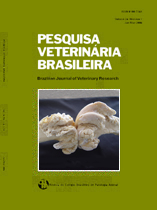 |
|
|
|
Year 2014 - Volume 34, Number 9
|

|
Spontaneous poisoning by Ricinus communis (Euphorbiaceae) in cattle, 34(9):827-831
|
ABSTRACT.- Albuquerque S.S.C., Rocha B.P., Albuquerque R.F., Oliveira J.S., Medeiros R.M.T., Riet-Correa F., Evêncio-Neto J. & Mendonça F.S. 2014. Spontaneous poisoning by Ricinus communis (Euphorbiaceae) in cattle. Pesquisa Veterinária Brasileira 34(9):827-831. Universidade Federal Rural de Pernambuco, Rua Dom Manoel de Medeiros s/n, Dois Irmãos, Recife, PE 52171-900, Brazil. E-mail: fabio.mendonca@pq.cnpq.br
The aim of this study is to report cases of spontaneous poisoning of cattle by Ricinus communis (castor beans) in Paraíba, a semiarid region of northeastern Brazil. The cases were observed in 2 herds on neighboring properties in 2013. Clinical signs developed within 6-24 h and consisted of weakness, tachycardia, dyspnea, profuse watery diarrhea, dehydration, depression, instability, cramps, permanent lateral recumbency and death within 48-72 h. Of the 60 cattle at risk, 19 were affected and 14 died. Five fully recovered after the course of 12 days. Three animals were necropsied. The main gross lesions were hemopericardium, hemothorax, pulmonary edema, petechial hemorrhages in the epicardium and endocardium, ecchymoses at the papillary muscles and suffusions on the intercostal muscles. Hemorrhages were also observed in the abdominal cavity, spleen and mucosa of the abomasum and small intestine. The rumen content was liquid with a large amount of castor bean seeds. There were circular, whitish and focally diffuse areas in the liver parenchyma. The main microscopic lesions consisted of multifocal coagulative myocardial necrosis with the presence of mononuclear cell infiltration and varying degrees of bleeding between cardiac muscle fibers. The abomasum and small intestine mucosae and submucosa had mild edema and mononuclear and polymorphonuclear inflammatory cell infiltration. The diagnosis of R. communis was based on the history of plant consumption, clinical signs, pathology of the disease and the presence of large amounts of castor bean seeds in the forestomachs. |
| |
|
|
| |
|
 |